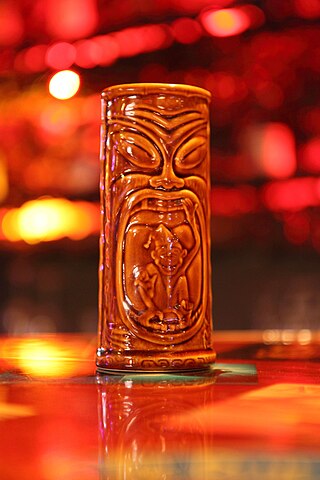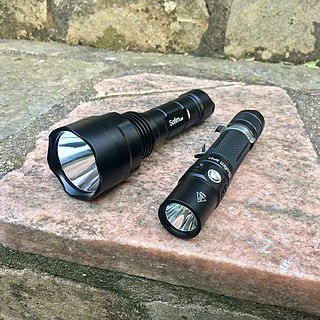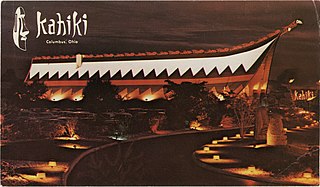
Tiki culture is an American-originated art, music, and entertainment movement inspired by Polynesian, Melanesian, and Micronesian cultures, and by Oceanian art. Influential cultures to Tiki culture include Australasia, Melanesia, Micronesia, Polynesia, the Caribbean Islands, and Hawaii. The name comes from Tiki, the Māori name for the first human, often represented in the form of hei-tiki, a pendant and important taonga. The hei-tiki was often appropriated by Europeans as a commercialised good luck charm, hence the name of Tiki culture. Despite spanning over 10,000 miles and including many different unrelated cultures, religions, and languages, Tiki aesthetic is considered by some to be amalgamated into one "fantasia of trans-Pacific cultures" and "colonial nostalgia". Because of this, and the simplistic view of the Pacific taken by the aesthetic, Tiki culture has often proved controversial.

A lantern is an often portable source of lighting, typically featuring a protective enclosure for the light source – historically usually a candle, a wick in oil, or a thermoluminescent mesh, and often a battery-powered light in modern times – to make it easier to carry and hang up, and make it more reliable outdoors or in drafty interiors. Lanterns may also be used for signaling, as torches, or as general light-sources outdoors.

A flashlight (US) or electric torch (CE), usually shortened to torch, is a portable hand-held electric lamp. Formerly, the light source typically was a miniature incandescent light bulb, but these have been displaced by light-emitting diodes (LEDs) since the early 2000s. A typical flashlight consists of the light source mounted in a reflector, a transparent cover to protect the light source and reflector, a battery, and a switch, all enclosed in a case.

Outdoor cooking is the preparation of food in the outdoors. A significant body of techniques and specialized equipment exists for it, traditionally associated with nomad in cultures such as the Berbers of North Africa, the Arab Bedouins, the Plains Indians, pioneers in North America, and indigenous tribes in South America. These methods have been refined in modern times for use during recreational outdoor pursuits, by campers and backpackers.

In the signage industry, neon signs are electric signs lighted by long luminous gas-discharge tubes that contain rarefied neon or other gases. They are the most common use for neon lighting, which was first demonstrated in a modern form in December 1910 by Georges Claude at the Paris Motor Show. While they are used worldwide, neon signs were popular in the United States from about the 1920s to 1950s. The installations in Times Square, many originally designed by Douglas Leigh, were famed, and there were nearly 2,000 small shops producing neon signs by 1940. In addition to signage, neon lighting is used frequently by artists and architects, and in plasma display panels and televisions. The signage industry has declined in the past several decades, and cities are now concerned with preserving and restoring their antique neon signs.

The Kon-Tiki expedition was a 1947 journey by raft across the Pacific Ocean from South America to the Polynesian islands, led by Norwegian explorer and writer Thor Heyerdahl. The raft was named Kon-Tiki after the Inca god Viracocha, for whom "Kon-Tiki" was said to be an old name. Heyerdal's book on the expedition was entitled The Kon-Tiki Expedition: By Raft Across the South Seas. A 1950 documentary film won the Academy Award for Best Documentary Feature. A 2012 dramatized feature film was nominated for the Academy Award for Best Foreign Language Film.

A sodium-vapor lamp is a gas-discharge lamp that uses sodium in an excited state to produce light at a characteristic wavelength near 589 nm.

A street light, light pole, lamp pole, lamppost, street lamp, light standard, or lamp standard is a raised source of light on the edge of a road or path. Similar lights may be found on a railway platform. When urban electric power distribution became ubiquitous in developed countries in the 20th century, lights for urban streets followed, or sometimes led.

Fire performance is a group of performance arts or skills that involve the manipulation of fire. Fire performance typically involves equipment or other objects made with one or more wicks which are designed to sustain a large enough flame to create a visual effect.

Christmas lights are lights often used for decoration in celebration of Christmas, often on display throughout the Christmas season including Advent and Christmastide. The custom goes back to when Christmas trees were decorated with candles, which symbolized Christ being the light of the world. The Christmas trees were brought by Christians into their homes in early modern Germany.

Gas lighting is the production of artificial light from combustion of a fuel gas such as hydrogen, methane, carbon monoxide, propane, butane, acetylene, ethylene, coal gas or natural gas. The light is produced either directly by the flame, generally by using special mixes of illuminating gas to increase brightness, or indirectly with other components such as the gas mantle or the limelight, with the gas primarily functioning as a heat source for the incandescence of the gas mantle or lime.

A theme restaurant is a type of restaurant that uses theming to attract diners by creating a memorable experience. Theme restaurants have a unifying or dominant subject or concept, and utilize architecture, decor, special effects, and other techniques, often to create exotic environments that are not normally associated with dining because they are inaccessible, no longer exist, are fictional or supernatural, or taboo. The theme may be further extended through the naming and choices of food, though food is usually secondary to entertaining guests.

A light fixture, light fitting, or luminaire is an electrical lighting device containing one or more light sources, such as lamps, and all the accessory components required for its operation to provide illumination to the environment. All light fixtures have a fixture body and one or more lamps. The lamps may be in sockets for easy replacement—or, in the case of some LED fixtures, hard-wired in place.

A tiki bar is a themed drinking establishment that serves elaborate cocktails, especially rum-based mixed drinks such as the Mai Tai and Zombie cocktails. Tiki bars are aesthetically defined by their tiki culture décor which is based upon a romanticized conception of tropical cultures, most commonly Polynesian. Some bars also incorporate general nautical themes or retro elements from the early atomic age.

Bar stools are a type of tall stool, often with a foot rest to support the feet. The height and narrowness of bar stools make them suitable for use at bars and high tables in pubs or bars.
Worthington Enterprises, Inc. is a global diversified metals manufacturing company based in Columbus, Ohio. It is a steel processor and manufacturer of pressure vessels, such as propane, oxygen and helium tanks, hand torches, refrigerant and industrial cylinders, camping cylinders, exploration, recovery and production products for global energy markets; water system tanks for storage, treatment, heating, expansion and flow control, and compressed natural gas storage cylinders. The company also manufactures framing systems for mid-rise buildings and steel pallets and racks for shipping. It is the largest independent processor of flat-rolled steel in the United States. The company takes steel from steel producers and processes it for customers in industries including automotive, lawn and garden, construction, hardware, office furniture, electrical control, leisure and recreation, appliance, agriculture and HVAC.

Oxy-fuel welding and oxy-fuel cutting are processes that use fuel gases and oxygen to weld or cut metals. French engineers Edmond Fouché and Charles Picard became the first to develop oxygen-acetylene welding in 1903. Pure oxygen, instead of air, is used to increase the flame temperature to allow localized melting of the workpiece material in a room environment. A common propane/air flame burns at about 2,250 K, a propane/oxygen flame burns at about 2,526 K, an oxyhydrogen flame burns at 3,073 K and an acetylene/oxygen flame burns at about 3,773 K.

Shelter Island is a neighborhood of Point Loma in San Diego, California, United States. It is actually not an island but is connected to the mainland by a narrow strip of land. It was originally a sandbank in San Diego Bay, visible only at low tide. It was built up into dry land using material dredged from the bay in 1934. It was developed in the 1950s and contains hotels, restaurants, marinas, and public parkland.

The Zombie Hut was a Hawaiian/Polynesian-themed restaurant, nightclub and Tiki bar located on Freeport Blvd. between Florin Road and Sutterville Road in Sacramento, California that originally opened in 1945 after the end of WWII and continuing for 45 years until its closing in 1990. Inspired by the 1930s Tiki craze, the restaurant was owned by Johnny Quaresma from 1945 to 1952 when Ed and Beatrice Hill purchased the business. The Hills eventually sold the Zombie Hut to Bruce Brooks, who owned it until its closing in 1990.

The Kahiki Supper Club was a Polynesian-themed restaurant in Columbus, Ohio. The supper club was one of the largest tiki-themed restaurants in the United States, and for a time, the only one in Ohio. It operated at its Eastmoor location on Broad Street beginning in 1961, at the height of tiki culture's popularity. The Kahiki was listed on the National Register of Historic Places in 1997, but closed and was demolished in 2000. It was described as an exceptionally important example of a themed restaurant and the most elaborate tiki restaurant ever built.



















